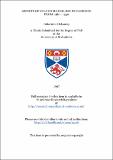Files in this item
Aspects of colour modelling in Florence from 1480 - 1530
Item metadata
| dc.contributor.advisor | Kemp, Martin | |
| dc.contributor.author | DeLancey, Julia Anne | |
| dc.coverage.spatial | 242 p. | en_US |
| dc.date.accessioned | 2018-07-12T13:47:35Z | |
| dc.date.available | 2018-07-12T13:47:35Z | |
| dc.date.issued | 1997 | |
| dc.identifier.uri | https://hdl.handle.net/10023/15316 | |
| dc.description.abstract | This thesis sets out to examine two new issues; the use of the colour modelling system in Florence in the late fifteenth and early sixteenth-centuries and the way it impacts the relationship between six artists who lived and worked for the most part in Florence during that period. Among these artists exist strong ties of studios, common patrons and working locations. Florence has traditionally been identified with disegno and Venice with colorito, although these associations are gradually being overturned; by looking at the clear and consistent use by Florentine artists of colour for expressive and volumetric means, it is hoped to gain a greater and more sophisticated understanding of these relationships. The first chapter looks at the work of Domenico Ghirlandaio and his bottega, one of the largest and for our purposes most influential studios in Florence; for comparison and also because of his role in the issue, Filippino Lippi enters as well. A chapter on Michelangelo, Ghirlandaio's most famous pupil, follows; the cleaned frescoes of the Sistine chapel provide one of the main foci of discussion for colour in the thesis, due to their great fame and dramatic colour use. These are discussed together with the Doni Tondo and the London Entombment. The middle two chapters focus on Andrea del Sarto, Fra Baitolommeo and the San Marco compagnia, the artists to stay in Florence after the departure of Leonardo, Michelangelo and Raphael and who taught many of the next generation of artists. The last two chapters deal with Jacopo Pontormo and Rosso Florentino; as heirs and successors to these earlier artists, Rosso and Pontormo continue in the use of this same colour modelling tradition, but employing it with dramatically different results. | en_US |
| dc.language.iso | en | en_US |
| dc.publisher | University of St Andrews | |
| dc.subject.lcc | ND621.F6D3 | en |
| dc.subject.lcsh | Painting, Italian. | en |
| dc.title | Aspects of colour modelling in Florence from 1480 - 1530 | en_US |
| dc.type | Thesis | en_US |
| dc.contributor.sponsor | Gapper Foundation | en_US |
| dc.contributor.sponsor | University of St Andrews | en_US |
| dc.contributor.sponsor | Russell Trust | en_US |
| dc.type.qualificationlevel | Doctoral | en_US |
| dc.type.qualificationname | PhD Doctor of Philosophy | en_US |
| dc.publisher.institution | The University of St Andrews | en_US |
This item appears in the following Collection(s)
Items in the St Andrews Research Repository are protected by copyright, with all rights reserved, unless otherwise indicated.

